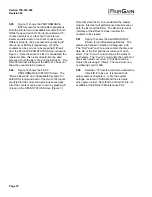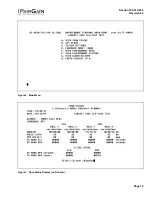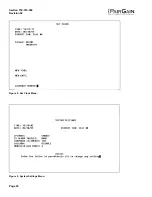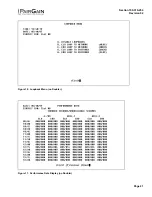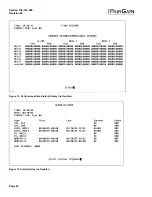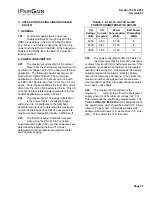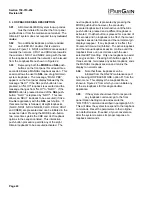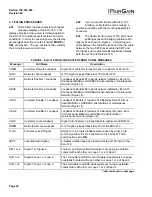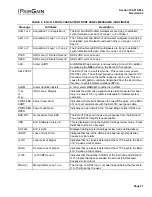
Section 150-319-254
Revision 02
Page 12
Maximum Current Drain:
•
Per Slot = 0.28 A
•
Per Shelf = 6.2 A
Note that the worst case conditions under which
these parameters were measured include a 3.3 km,
0.4 mm loop, a fully loaded 22-slot shelf and a -42.5
V shelf battery voltage.
2.02
The Maximum Power Dissipation measures
the power that is converted into heat build
up within the unit. It contributes to the total heat
generated in the space around the unit. It is used to
determine the maximum number of fully loaded
shelves per bay that does not exceed the maximum
allowable power dissipation density in Watts/sq. ft.
2.03
The thermal loading limitations imposed
when using the ELU-319 in Controlled
Environmental Vault (CEV) or other enclosures are
determined by applying the ELU-319 power
parameters to the manufacturer's requirements for
each specific housing.
2.04
The Maximum Power Consumption is the
total power that the ELU-319 consumes or
draws from its -48 V shelf power source. This
parameter is needed when the 319 is located remote
to its serving CO. It determines the battery capacity
required to maintain an 8-hour stand-by battery
reserve for emergency situations. It thus limits the
maximum number of plugs per remote enclosure.
Use the above data to perform this analysis on a
case by case basis.
2.05
The Maximum Current Drain is the
maximum
current drawn from the shelf power
supply when it is at its minimum voltage (-42.5 V).
This determines the shelf fusing requirements. The
PairGain HMS-318 and 317 ELU-319 shelves are
partitioned into two equal halves; each should be
fused at 10 A for a total of 20 A per shelf. A fully
loaded shelf draws 6.2 A worse case. This is within
the 10 A fuse limit.
3. LOOPBACK DESIGN DESCRIPTION
3.01
All HiGain ELU/ERU system loop-up codes
must be initiated from either the front panel
pushbuttons or from the maintenance terminal. The
HiGain E1 system does not respond to any
in-band
codes.
3.02
Depressing both the MODE and SEL
pushbuttons on the front panel for at least
three seconds initiates a MANUAL loopback
session. This session allows the user to SEL one of
four HiGain loopbacks (see Figure 5). The message
“MAN LPBK” appears on the front panel display
followed by the message “NLO?” If the SEL button
is now pressed, an NLOC loopback is executed and
the message changes from “NLO?” to “NLOC”. If
the MODE button is pressed instead of SEL button,
“NLO?” is replaced by “NRE?” If this same routine
is followed, all four loopbacks (NLOC, NREM,
CLOC, and CREM) are presented and can be
initiated in the sequence listed. Once a loopback is
executed, it can be terminated and the next
loopback option presented by pressing the MODE
button. If neither button is pressed for 30 seconds
and no loopback is in effect, this manual loopback
session terminates and the normal margin displays
reappear. If any loopback is in effect, this 30-
second time-out is inhibited. The active loopback
and the manual loopback session continue until the
loopback times out in accordance with the user
LBTO setting. Only one loopback may exist at any
given time. Depressing both buttons again for three
seconds terminates any active loopback, ends the
MANUAL loopback session, and returns the display
to normal.
3.03
Note that these same four loopbacks can be
initiated from the RS-232 maintenance port
by choosing LOOPBACK MODE, option D, from the
main menu. This displays the Loopback Menu,
shown in Figure 10, from which you can initiate any
of the four loopbacks.
3.04
The TLOS loopback (shown in Figure 5) is
controlled by a user switch option in the
ERU-412. When this option is enabled it forces the
ERU-412 into a logic loopback state when its G.703
input signal is lost. When this TLOS option is
disabled, no loop back occurs. When a LOS
condition exists the ELU-319 simply outputs the AIS
signal which alerts the network that a LOS condition
exists at the input to the ERL.
3.05
If the system should ever fail to respond to
any loopback command, go to the front
panel Option Setting mode and execute the
“DFLT/YES” command described in Section A,
paragraph 5.05. This will allow the system to
respond to the loopback commands. Reset the
parameters to their original non default values, if
needed, at your convenience, after the system
resumes its proper response to loopback
commands.


















